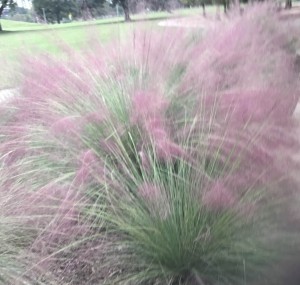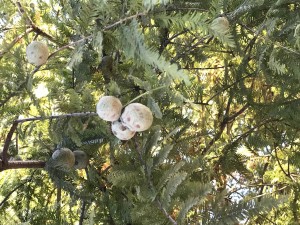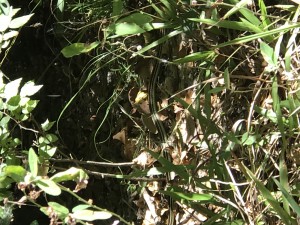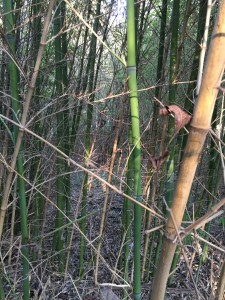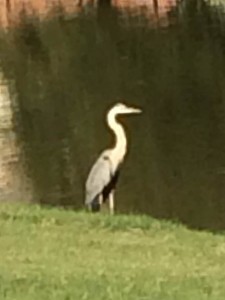This is an ornamental grass called Pink Muhly Grass (Muhlbergia capillaris), or cotton candy grass due to its bright pink-purple inflorescences which it grows in the fall. There are other varieties with white inflorescence and hybrids with other grass species. It is said to be native to Florida or the southeastern US and can grow naturally along coastal dunes. It grows in a clumping pattern, up to 3 or 4 feet tall, and it is drought- and salt-tolerant and resistant to deer. These features make it an appealing plant for landscaping because it’s very low maintenance. Since Pink Muhly is so easy to grow, it has been recommended by the California PlantRight program as an alternative to invasive grasses, such as pampas grass.
Author: tjohns10
Bald Cypress
I noticed this tree because its cones looked like bird eggs to me. This is a bald cypress (Taxodium distichum), called ‘bald’ because it is a deciduous conifer. In North America, some of the oldest livings things are these trees: the oldest specimen is in North Carolina, aged more than 1,620 years. They can grow up to 100 feet tall, and the tallest specimen is located near Williamsburg, Virginia. They grow fluted bases to help stabilize in wet soils; in fact, their root system is sturdy enough that even hurricanes rarely overturn them. Bald cypress swamps are some of the most productive ecosystems, and they historically dominated the swamps of the southeastern United States. This is a popular ornamental/landscape tree species, and the wood is also valued for its strong water resistance. The bald cypress is the official state tree of Louisiana.
This week I saw a garter snake (Thamnophis) while I was walking near a creek. Although this is a common species, I didn’t know much about them, so here are some facts I learned: bullfrogs are one of their natural predators; they’re collected for the pet trade; they almost exclusively utilize habitat near a water source; they hibernate and often in a communal setting in sites called “hibernacula”; lastly, despite belief to the contrary, they are actually venomous, just not enough to kill a human.
Red Velvet Ant
This weekend I spotted an insect I’d never seen before, but luckily its uniqueness made it easy to identify: the red velvet ant (Dasmyutilla occidentalis). Despite its name (it’s also known as “cow killer”), it is actually a wasp. It is the largest of the velvet ants. They’re parasitic to immature wasps and ground-nesting bees, utilizing their nests and eating through cocoons to lay their own larva. The one I came across was wingless which indicates it was a female. The name cow killer is said to refer to their painful sting, but they are not actually known to sting cattle. Although their sting is painful, they are known to be non-aggressive and will seek cover if pursued — which is just what this one did when I tried to get a picture of it. They can even emit a “squeaking sound” when disturbed. This species is uncommon and does not require any kind of control (e.g. pesticides) to manage.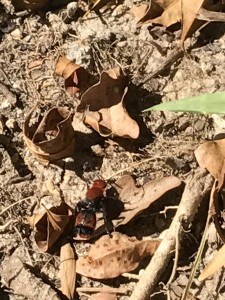
Bamboo Adventure
This week I took greater notice of something I see nearly every day — the patch of bamboo at the dog park. I think it’s grown there simply to provide variety to the areas for the dogs to explore, but not until moving to the south had I ever seen it also grown in many people’s yards and gardens. According to Feng Shui principles, bamboo at the front of the house ensures long lives of those in the household. Bamboos (Bambusoideae) encompass 1,439 species, and it is the fastest growing plant on the planet. Everyone knows about bamboo’s importance to pandas, but bamboo has a lot of cultural significance as well: Hindu flags are flown on bamboo flagpoles; bamboo paper is used to make ‘spirit money’ (money burnt in offering to those in the afterlife) among some Chinese communities, and the first ever gunpowder-based weapons were crafted from bamboo. Bamboo is present in mythology and folklore across numerous cultures, including the Philippines, Malaysia, Japan, and Hawaii.
Botanical Gardens Vancouver
This past weekend I was out of town visiting Vancouver for the first time. The foliage there is now a blend of green with warm reds, oranges, and yellows, which helped catch my attention for my biodiversity observation: the tulip tree. Specifically, this was a Chinese tulip tree (Liriodendron chinense) at the VanDusen Botanical Gardens. This has been one of my favorite trees since I first learned to identify it by its leaves which resemble a cat’s face when held upright by the petiole. Liriodendron means “lily tree” in Greek, but this species is also called the yellow poplar within the lumber industry. Its wood is used for numerous purposes, from house interiors to organs. In the past, Native Americans used the trunks to carve out their canoes so often that they called it “canoewood”. The tulip tree is the state tree of Tennessee, Kentucky, and Indiana, likely because of its remarkable leaves and beautiful flowers.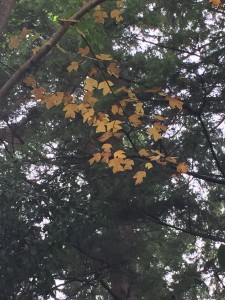
Birds at Home
Today by my parents’ house I spotted a Great Blue Heron (Ardea herodias). This species is highly adaptable and ranges widely across the US year-round. They prefer marshland habitat and mostly nest in trees. It is the largest of the North American herons, but despite their size, they typically weigh around 5 pounds partially due to their hollow bones. The oldest documented Great Blue Heron was found in Texas, aged at least 24 years and 6 months old. I’ve always enjoyed watching their slow, deliberate walk through the water searching for something to eat, similar to their calm, unhurried wingbeats when they take flight.
www.inaturalist.org/observations/4143234
